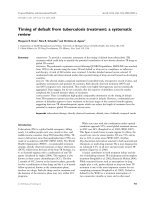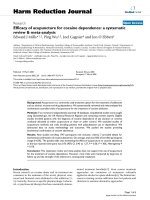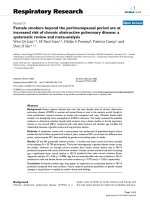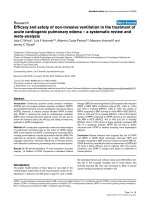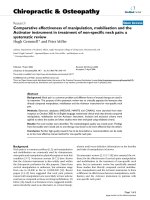Intravenous lipid emulsions and risk of hepatotoxicity ininfants and children: a systematic review and meta-analysis | Website Bệnh viện nhi đồng 2 - www.benhviennhi.org.vn
Bạn đang xem bản rút gọn của tài liệu. Xem và tải ngay bản đầy đủ của tài liệu tại đây (888.52 KB, 22 trang )
ESPGHAN Committee on Nutrition Position Paper
Intravenous Lipid Emulsions and risk
of Hepatotoxicity in
Infants and Children: a Systematic
Review and Meta-analysis
DR. Nguyen Thi Kim Ngan
Disgestive Department – Children’s Hospital No.2
Content
1. Introduction
2. Materials and methods
3. Results
4. Conclusions
5. Recommendations
Introduction
• Parenteral Nutrition (PN): in patients not fully
tolerating enteral nutrition/intestinal failure (IF) [1].
• PN-associated liver disease (PNALD): cholestasis and
exclude other causes of liver injury [2,3].
• Cholestasis: direct bilirubin(>=2 mg/dL[34.2 mmol/L])
[4].
• The mechanism of PNALD is multifactorial: immature
liver function, inflammatory mediators, short bowel
syndrome, parenteral nutrition components
(especially lipid emulsions)[5].
Introduction
• PNALD may develop in 40% to 60% of infants
[6] and up to 85% of neonates [7] who require
long-term PN.
• Intravenous lipid emulsion (ILE) prevents
many complications: essential fatty acid
deficiency, hyperglycaemia and hepatic
steatosis [8,9].
Introduction
Different types of intravenous lipid emulsions:
Fig. 1 Characteristics of commercially available intravenous lipid emulsions used in reported randomized
controlled trials (Journal of Pediatric Gastroenterology and Nutrition. 62(5):776-792, May 2016)
Introduction
Recent new generation of ILE (FO & SMOFLipid):
promising results in the prevention and
treatment of PNALD.
The aim of the present article: summarizing
the scientific evidence (23 RCTs) about role of
different ILE in the pathogenesis and the effect
of different types of ILE on PNALD.
Materials and Methods
• Journal of Pediatric Gastroenterology & Nutrition
– Volume 62 - 5/2016
• A systematic review: PubMed, EMBASE, and
Cochrane Central Register of Controlled Trials
CENTRAL search up to March 2015.
• The primary outcome: incidence of cholestasis.
• Secondary outcomes: total and conjugated
bilirubin and liver enzymes ( ALT, AST, ALP, GGT)
after the use of ILE.
Materials and Methods
Fig. 2 Flow chart of search results.
Results
1. Short-term (3–27 days) use in neonates
including preterm infants:17 RCTs
• 5 studies: between OO/SO (Clinoleic 20%) &
SO (Intralipid 20%), 4 studies found no
difference in the bilirubin and/or liver
enzymes between groups. The largest study,
however, found lower direct bilirubin after 7
days with OO/SO ILE.
• 2 studies compared MCT/SO-based
(Lipofundin 20% ) & SO (Intralipid 20% ) with
no difference between groups.
Results
1. Short-term (3–27 days) use in neonates
including preterm infants:17 RCTs
• 6 studies compared multicomponent FOcontaining IL (SMOFlipid 20%) to SO (Intralipid
20%).
• 2 studies found a greater decrease in bilirubin
levels in SMOFlipid group, 1 study found lower
GGT in SMOFlipid group. 3 studies found no
difference in the cholestasis rate between
groups.
Results
1. Short-term (3–27 days)use in neonates including
preterm infants:17 RCTs
• Comparison of different ILEs: no difference in
bilirubin levels and liver enzymes between groups.
• Primary outcome: 4 studies found no difference
any experimental mixed ILE compared to solely SO
ILE (Fig. 3)
• Secondary outcomes: All studies reported total
bilirubin after the intervention and found no
difference in overall effect and subgroup analysis
(Fig. 4). Similarly, no difference for conjugated
bilirubin, ALP, GGT, AST and ALT.
Results
Fig. 3 Effect of mixed intravenous lipid emulsions on cholestasis rate in comparison
to pure soya bean–based lipid emulsion in neonates including preterm infants
Results
Fig .4 Effect of mixed intravenous lipid emulsions on total bilirubin levels (μmol/L) in
comparison to pure SO-based lipid emulsion in neonates including preterm infants)
Results
2. Long-term use in neonates (more than 4
weeks):
• Only 1 RCT evaluated the use of FO ILE
(Omegaven 10%) compared to SO ILE (Intralipid
20%) in neonates who required long-term PN.
19 neonates no difference in direct bilirubin
and liver function between groups.
Results
3. Children with short-term PN:
• 2 studies evaluated the safety and efficacy of
different ILE in children (OO & MCT). None of the
studies evaluated the influence of different ILE on
liver function tests or bilirubin levels and none
reported cholestasis rate.
• 1 study included children after bone marrow
transplantation and compared MCT/SO
(Lipofundin 20% ) and OO/SO ILE (Clinoleic 20% )
found no difference between groups in bilirubin
levels and liver function tests.
Results
4. Infants and children with long-term PN:
• 3 RCTs: no difference in the liver enzymes,
bilirubin levels between groups.
• The present study found a decrease in the
bilirubin levels in the multicomponent FOcontaining group and an increase in the SO
group.
• Another study also showed a decrease in
direct bilirubin and ALT levels in infants on FO
compared with those on SO.
Conclusions
The ESPGHAN Committee on Nutrition (CoN)
concludes:
• No evidence of a difference in total bilirubin,
conjugated bilirubin, AST, ALT, ALP, and GGT
between short-term use of OO/SO and SO ILE
in infants and children (level of evidence 2A).
• No evidence of a difference in bilirubin,
conjugated bilirubin, AST, ALT, ALP, and GGT
between short-term use of multicomponent
FO-containing ILE and SO ILE in neonates (level
of evidence 2A).
Conclusions
• The use of multicomponent FO-containing ILE
may contribute to a decrease in total bilirubin
levels in children with prolonged PN (level of
evidence 2B).
• Pure FO supply combined with a decrease or
interruption of SO ILE may contribute to
cholestasis recovery in children with PNALD
(level of evidence 2B).
Recommendations
• Prevention and care of PNALD in children
should not be focused exclusively on parenteral
ILE intake.
• Based on available evidence, the CoN cannot
currently recommend the use of any specific ILE
for short-term use in infants and children for
the prevention and treatment of PNALD (GR B).
• For children in whom long-term use of PN is
expected, it appears prudent to use
multicomponent FO-containing ILE (GR C).
Recommendations
• The present evidence base is inadequate to
determine the optimal strategy for intravenous
lipid supply in infants and children to prevent or
treat liver complications.
• Studies on both the prevention and treatment of
PNALD should be conducted in high-risk infants
and children who are likely to require long-term
PN, and should also consider additional
extrahepatic outcomes such as growth and
cognition.
References
•
•
•
•
•
•
•
•
•
[1] D’antiga L, Goulet O. Intestinal failure in children: the European view. J
Pediatr Gastroenterol Nutr 2013; 56:118–126.
[2] Colomb V, Goulet O, Rambaud C, et al. Long-term parenteral nutrition in
children: liver and gallbladder disease. Transplant Proc 1992; 24:1054–1055.
[3] Peyret B, Collardeau S, Touzet S, et al. Prevalence of liver complications in children
receiving long-term parenteral nutrition. Eur J Clin Nutr 2011; 65:743–749.
[4] Klein CJ, Revenis M, Kusenda C, et al. Parenteral nutrition-associated
conjugated hyperbilirubinemia in hospitalized infants. J Am Diet Assoc 2010;
110:1684–1695.
[5] Moss RL, Amii LA. New approaches to understanding the etiology and treatment of
total parenteral nutrition-associated cholestasis. Semin Pediatr Surg 1999; 8:140.
[6] Kelly DA. Intestinal failure-associated liver disease: what do we know
today? Gastroenterology 2006; 130:S70–S77.
[7] Nehra D, Fallon EM, Puder M. The prevention and treatment of intestinal failureassociated liver disease in neonates and children. Surg Clin North Am 2011; 91:543–
563.
[8] Keim NL. Nutritional effectors of hepatic steatosis induced by parenteral nutrition in
the rat. JPEN J Parenter Enteral Nutr 1987; 11:18–22.
[9] Reif S, Tano M, Oliverio R, et al. Total parenteral nutrition-induced steatosis:
reversal by parenteral lipid infusion. JPEN J Parenter Enteral Nutr 1991;
15:102–104.
